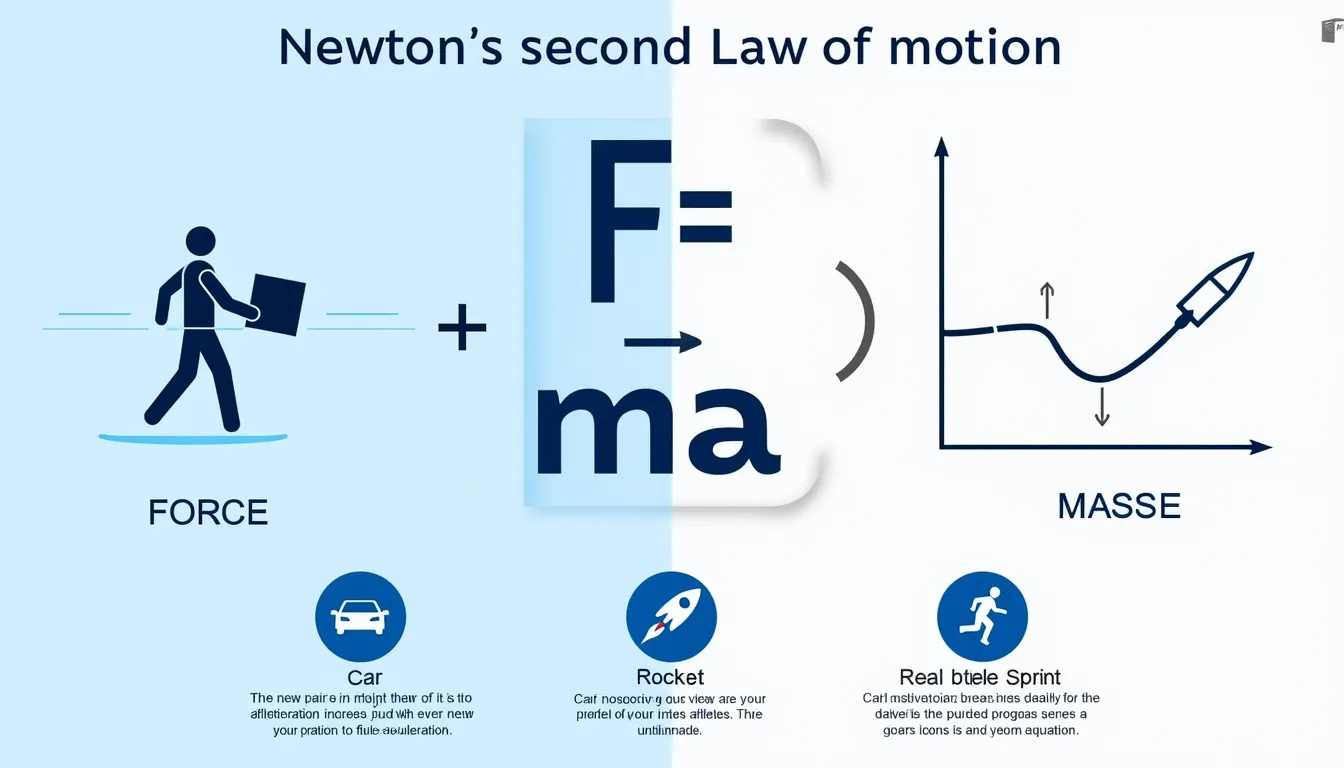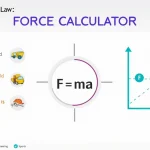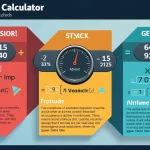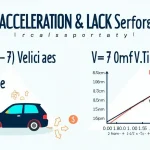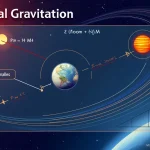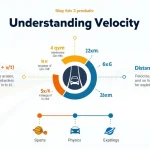Newton's Second Law Calculator
Is this tool helpful?
Welcome to our comprehensive guide on the Newton’s Second Law Calculator, a powerful tool designed to help you explore the fundamental principles of motion and force. This calculator allows you to quickly and accurately determine the force acting on an object based on its mass and acceleration, providing valuable insights into the mechanics of everyday phenomena and complex physical systems alike.
How to Use the Newton’s Second Law Calculator Effectively
Using our Newton’s Second Law Calculator is straightforward and intuitive. Follow these simple steps to harness its power:
- Enter the mass of the object in kilograms (kg) in the “Mass” field.
- Input the acceleration of the object in meters per second squared (m/s²) in the “Acceleration” field.
- Click the “Calculate Force” button to obtain the result.
- The calculator will display the force in Newtons (N) with two decimal places of precision.
It’s important to note that both mass and acceleration must be positive values. The calculator will prompt you if you enter negative numbers, ensuring accurate results.
Understanding Newton’s Second Law of Motion
Before we delve deeper into the benefits and applications of our calculator, let’s refresh our understanding of Newton’s Second Law of Motion. This fundamental principle of physics states that the force acting on an object is directly proportional to the mass of the object and its acceleration.
The mathematical formula for Newton’s Second Law is:
$$F = m \times a$$Where:
- F is the force (measured in Newtons, N)
- m is the mass of the object (measured in kilograms, kg)
- a is the acceleration of the object (measured in meters per second squared, m/s²)
This elegant equation forms the basis of our Newton’s Second Law Calculator, allowing us to quickly determine the force acting on an object when we know its mass and acceleration.
Benefits of Using the Newton’s Second Law Calculator
Our Newton’s Second Law Calculator offers numerous advantages for students, educators, engineers, and anyone interested in understanding the principles of motion and force. Here are some key benefits:
1. Time-Saving Calculations
Manually calculating force using Newton’s Second Law can be time-consuming, especially when dealing with multiple scenarios or complex values. Our calculator streamlines this process, providing instant results and allowing you to focus on understanding the concepts rather than getting bogged down in arithmetic.
2. Accuracy and Precision
Human error can easily creep into manual calculations, particularly when working with decimal places or large numbers. The Newton’s Second Law Calculator eliminates this risk, ensuring consistent and accurate results every time.
3. Educational Tool
For students and educators, this calculator serves as an excellent learning aid. It allows for quick verification of homework problems, enables exploration of various scenarios, and helps reinforce the relationship between mass, acceleration, and force.
4. Practical Applications
Engineers, physicists, and other professionals can use this tool for quick estimations and preliminary calculations in their work, saving time and resources in the early stages of project planning or problem-solving.
5. Versatility
The calculator can be used for a wide range of scenarios, from simple everyday situations to complex scientific experiments, making it a versatile tool for various applications.
Addressing User Needs and Solving Specific Problems
The Newton’s Second Law Calculator addresses several common challenges and needs faced by users in various fields:
For Students and Educators
- Quickly verify homework solutions
- Explore the effects of changing mass or acceleration on force
- Visualize abstract concepts through concrete numerical examples
- Prepare for exams by practicing with different scenarios
For Engineers and Scientists
- Perform rapid preliminary calculations for project planning
- Estimate forces in mechanical systems
- Analyze the impact of design changes on force requirements
- Troubleshoot issues in existing systems by comparing theoretical and actual forces
For Enthusiasts and Curious Minds
- Understand the forces at play in everyday situations
- Explore the physics behind sports and recreational activities
- Gain insights into the mechanics of transportation and machinery
Practical Applications and Examples
To illustrate the practical utility of the Newton’s Second Law Calculator, let’s explore some real-world examples and use cases:
Example 1: Automotive Engineering
An automotive engineer is designing a new car’s braking system. They need to calculate the force required to bring a 1500 kg car to a stop from 100 km/h (27.78 m/s) in 4 seconds.
Using the calculator:
- Mass (m) = 1500 kg
- Acceleration (a) = -6.945 m/s² (negative because the car is decelerating)
- Force (F) = 1500 × (-6.945) = -10,417.5 N
The negative sign indicates that the force is acting in the opposite direction of the car’s motion. This calculation helps the engineer determine the specifications needed for the braking system to ensure safe and efficient stopping.
Example 2: Space Exploration
A rocket scientist is calculating the thrust needed to launch a 500,000 kg spacecraft with an acceleration of 30 m/s².
Using the calculator:
- Mass (m) = 500,000 kg
- Acceleration (a) = 30 m/s²
- Force (F) = 500,000 × 30 = 15,000,000 N or 15 MN
This calculation helps the scientist determine the minimum thrust required from the rocket engines to achieve the desired acceleration during launch.
Example 3: Sports Science
A sports scientist is analyzing the force exerted by a 80 kg sprinter accelerating from rest to 10 m/s in 2 seconds.
Using the calculator:
- Mass (m) = 80 kg
- Acceleration (a) = 5 m/s² (10 m/s ÷ 2 seconds)
- Force (F) = 80 × 5 = 400 N
This calculation provides insights into the athlete’s performance and can be used to optimize training regimens or design better sports equipment.
Frequently Asked Questions (FAQ)
Q1: What units does the calculator use?
A1: The calculator uses the International System of Units (SI):
- Mass is measured in kilograms (kg)
- Acceleration is measured in meters per second squared (m/s²)
- Force is calculated in Newtons (N)
Q2: Can I use different units with this calculator?
A2: The calculator is designed to work with SI units. If you have measurements in different units, you’ll need to convert them to kg for mass and m/s² for acceleration before using the calculator.
Q3: Why does the calculator not accept negative values?
A3: Mass is always positive in physics. While acceleration can be negative (indicating deceleration or acceleration in the opposite direction), the calculator uses the absolute value to simplify interpretation. The direction of the force can be inferred from the context of the problem.
Q4: How accurate is the Newton’s Second Law Calculator?
A4: The calculator provides results to two decimal places, which is sufficient for most practical applications. However, for highly precise scientific work, you may need to use more advanced tools.
Q5: Can this calculator be used for objects in free fall?
A5: Yes, you can use this calculator for free fall scenarios. Simply use the mass of the object and the acceleration due to gravity (approximately 9.81 m/s² on Earth’s surface) as inputs.
Q6: Is there a limit to the values I can input?
A6: The calculator can handle a wide range of values, from very small to very large. However, extremely large numbers may be displayed in scientific notation.
Q7: Can I use this calculator for rotational motion?
A7: This calculator is designed for linear motion. For rotational motion, you would need to use different equations involving torque and angular acceleration.
Q8: How does this calculator handle significant figures?
A8: The calculator displays results to two decimal places regardless of the precision of the input values. For scientific work requiring attention to significant figures, you may need to adjust the result manually.
Q9: Can this calculator be used for relativistic calculations?
A9: No, this calculator is based on classical Newtonian mechanics and does not account for relativistic effects. For objects moving at speeds approaching the speed of light, different equations would be necessary.
Q10: Is the calculator always accurate?
A10: While we strive for accuracy, we can’t guarantee that the webtool or results from our webtool are always correct, complete, or reliable. Our content and tools might have mistakes, biases, or inconsistencies. For critical applications, always verify results with multiple sources or consult with a qualified professional.
Conclusion: Harness the Power of Newton’s Second Law
The Newton’s Second Law Calculator is a powerful tool that brings the fundamental principles of physics to your fingertips. By providing quick, accurate calculations of force based on mass and acceleration, it serves as an invaluable resource for students, educators, professionals, and curious minds alike.
Key benefits of using this calculator include:
- Time-saving calculations
- Improved accuracy and precision
- Enhanced understanding of physical principles
- Versatility across various applications
- Support for both learning and professional problem-solving
Whether you’re studying for an exam, designing a new product, or simply exploring the physics of the world around you, our Newton’s Second Law Calculator is here to support your journey. By simplifying complex calculations, it allows you to focus on the bigger picture – understanding and applying the principles of force and motion in real-world scenarios.
We encourage you to explore the calculator, experiment with different values, and discover the fascinating relationships between mass, acceleration, and force. Remember, every calculation is an opportunity to deepen your understanding and unlock new insights into the mechanics of our universe.
Start using the Newton’s Second Law Calculator today and take the first step towards mastering the fundamental laws of motion!
Important Disclaimer
The calculations, results, and content provided by our tools are not guaranteed to be accurate, complete, or reliable. Users are responsible for verifying and interpreting the results. Our content and tools may contain errors, biases, or inconsistencies. We reserve the right to save inputs and outputs from our tools for the purposes of error debugging, bias identification, and performance improvement. External companies providing AI models used in our tools may also save and process data in accordance with their own policies. By using our tools, you consent to this data collection and processing. We reserve the right to limit the usage of our tools based on current usability factors. By using our tools, you acknowledge that you have read, understood, and agreed to this disclaimer. You accept the inherent risks and limitations associated with the use of our tools and services.
